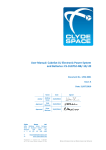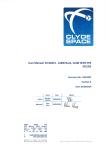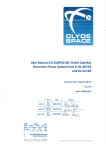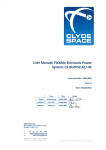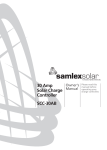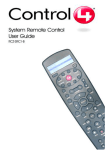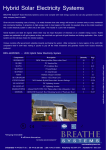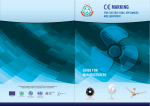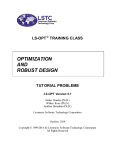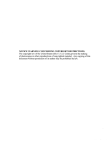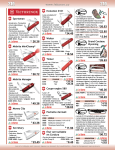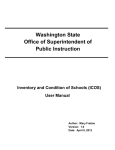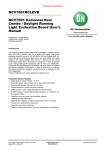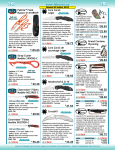Download User Manual: CubeSat 2U Electronic Power System
Transcript
User Manual: CubeSat 2U Electronic Power System and Batteries: CS-2UEPS2-NB/-10/-20 Document No.: USM-01-00842 Issue: B Date: 20/03/2013 Name Date Author Andrew Strain 14/05/2012 Last Update Alan Kane 20/03/13 Kevin Worrall 20/03/13 Approved Signed Clyde Space Ltd. Helix Building, Kelvin Campus, West of Scotland Science Park, Glasgow G20 0SP, UK. t: + 44 (0) 141 946 4440 e: w: [email protected] www.clyde-space.com Registered in Scotland No. SC285287 at 123 St Vincent Street Glasgow G2 5EA SOLUTIONS FOR A NEW AGE IN SPACE Document: USM-01-00842 User Manual: CubeSat 2U Electronic Power System and Batteries: CS-2UEPS2-NB/-10/-20 Issue: B Date: 20/03/2013 Helix Building, WSSP, Glasgow G20 0SP, UK Page: 2 of 55 Document Control Issue Date Section Description of Change A 14/05/12 All First Release B 04/03/13 Section 9.5, table 3.1, table 4.1 Update current trip points to reflect hardware build standard. Section table 11-1 11.3, Add documentation for heater status command. Section table 11-1 11.2, Update I2C address to match software Reason for Change ECN xxxxx Revision Control Product Part Number Revisions covered Cubesat 2U Electronic Power System 2G with no battery CS-2UEPS2-NB A-E Cubesat 2U Electronic Power System 2G with 10Wh battery CS-2UEPS2-10 A-E Cubesat 2U Electronic Power System 2G with 20Wh battery CS-2UEPS2-20 A-E Notes Acronyms and Abbreviations BCR Battery Charge Regulator PCM Power Conditioning Module PDM Power Distribution Module MPPT Maximum Power Point Tracker USB Universal Serial Bus ESD Electro Static Discharge TLM Telemetry EPS Electrical Power System EoC End of Charge AMUX Analogue Multiplexer ADC Analogue to Digital Converter AIT Assembly, Integration and Testing 1U 1 Unit (Cubesat standard size) 2U 2 Unit (Cubesat standard size) 3U 3 Unit (Cubesat standard size) FleXU FleXible Unit (suitable for various satellite configurations) rh Relative Humidity Wh Watt Hour Ah Ampere Hour DoD Kbits -1 Depth of Discharge Kilobits per second SOLUTIONS FOR A NEW AGE IN SPACE PROPRIETARY & CONFIDENTIAL INFORMATION www.clyde-space.com © Clyde Space Limited 2012 Document: USM-01-00842 User Manual: CubeSat 2U Electronic Power System and Batteries: CS-2UEPS2-NB/-10/-20 Issue: B Date: 20/03/2013 Voc Open Circuit Voltage Isc Short Circuit Current Helix Building, WSSP, Glasgow G20 0SP, UK Page: 3 of 55 2s1p Battery configuration – 2 cells in series, 1 battery in parallel (single string) 2s2p Battery configuration – 2 cells in series, 2 batteries in parallel 2s3p Battery configuration – 2 cells in series, 3 batteries in parallel Related Documents No. Document Name Doc Ref. RD-1 CubeSat Design Specification CubeSat Design Specification Rev. 12 RD-2 NASA General Environmental Verification Standard GSFC-STD-7000 April 2005 RD-3 CubeSat Kit Manual UM-3 RD-4 Solar Panel User Document Power System Design and Performance on the World’s Most Advanced In-Orbit Nanosatellite TBC RD-5 # As named Risk Warning 1 Ensure headers H1 and H2 are correctly aligned before mating boards If misaligned, battery positive can short to ground, causing failure of the battery and EPS 2 Ensure switching configuration is implemented correctly before applying power to EPS If power is applied with incorrect switch configuration, the output of the BCR can be blown, causing failure of the EPS and subsequent damage to the battery 3 Observe ESD precautions at all times The battery is a static sensitive system. Failure to observe ESD precautions can result in failure of the battery 4 Ensure not to exceed the maximum stated limits Exceeding any of the stated maximum limits can result in failure of the battery 5 Ensure batteries are fully isolated during storage If not fully isolated (by switch configuration or separation) the battery may over-discharge, resulting in failure of the battery 6 No connection should be made to H2.35-36 These pins are used to connect the battery to the EPS. Any connections to the unregulated battery bus should be made to pins H2.43-44 7 H1 and H2 pins should not be shorted at any time These headers have exposed live pins which should not be shorted at any time. Particular care should be taken regarding the surfaces these are placed on. 8 Battery should only integrated with an EPS The EPS includes a number of protection circuits for the battery. Operation without these protections may lead to damage of the batteries 9 Do not discharge batteries below 6V If the battery is discharged to a voltage below 6V the cells have been compromised and will no longer hold capacity If batteries are over-discharged DO NOT attempt to recharge If the battery is over discharged (below 6V) it should not be recharged as this may lead to cell rupture. 10 10 be operated SOLUTIONS FOR A NEW AGE IN SPACE PROPRIETARY & CONFIDENTIAL INFORMATION when www.clyde-space.com © Clyde Space Limited 2012 Document: USM-01-00842 Issue: B 1. User Manual: CubeSat 2U Electronic Power System and Batteries: CS-2UEPS2-NB/-10/-20 Date: 20/03/2013 Page: 4 of 55 Helix Building, WSSP, Glasgow G20 0SP, UK Introduction .......................................................................................................................... 6 1.1 Additional Information Available Online ............................................................................................6 1.2 Continuous Improvement...................................................................................................................6 1.3 Document Revisions ...........................................................................................................................6 2. Overview ............................................................................................................................... 7 3. Maximum Ratings(1) .............................................................................................................. 8 4. Electrical Characteristics ....................................................................................................... 9 5. Handling and Storage ......................................................................................................... 11 5.1 Electro Static Discharge (ESD) Protection .........................................................................................11 5.2 General Handling ..............................................................................................................................11 5.3 Shipping and Storage ........................................................................................................................11 6. Materials and Processes ..................................................................................................... 12 6.1 Materials Used..................................................................................................................................12 6.2 Processes and Procedures ................................................................................................................12 7. System Description ............................................................................................................. 13 7.1 System Overview ..............................................................................................................................15 7.2 Protection and Redundancy .............................................................................................................16 7.3 Quiescent Power Consumption ........................................................................................................16 7.4 Mass and Mechanical Configuration ................................................................................................16 8. Interfacing........................................................................................................................... 18 8.1 Connector Layout .............................................................................................................................19 8.2 Solar Array Connection .....................................................................................................................20 8.3 Solar Array Harness ..........................................................................................................................23 8.4 Temperature Sensing Interface ........................................................................................................23 8.5 Non-Clyde Space Solar Arrays...........................................................................................................23 8.6 CubeSat Kit Compatible Headers ......................................................................................................24 8.7 Cubesat Kit Header Pin Definitions ...................................................................................................25 8.8 Switch Options ..................................................................................................................................26 8.9 Battery Connection ...........................................................................................................................28 8.10 Buses ................................................................................................................................................28 9. Technical description .......................................................................................................... 29 9.1 Charge Method .................................................................................................................................29 9.2 BCR Power Stage Overview ..............................................................................................................30 9.3 MPPT ................................................................................................................................................30 9.4 Discharge ..........................................................................................................................................31 9.5 5V and 3.3V PCM ..............................................................................................................................31 9.6 Battery Heater ..................................................................................................................................31 9.7 Cell Lot Acceptance Testing ..............................................................................................................32 10. General Protection ............................................................................................................. 39 SOLUTIONS FOR A NEW AGE IN SPACE PROPRIETARY & CONFIDENTIAL INFORMATION www.clyde-space.com © Clyde Space Limited 2012 Document: USM-01-00842 Issue: B User Manual: CubeSat 2U Electronic Power System and Batteries: CS-2UEPS2-NB/-10/-20 Date: 20/03/2013 Page: 5 of 55 Helix Building, WSSP, Glasgow G20 0SP, UK 10.1 Over-Current Bus Protection ............................................................................................................39 10.2 Battery Under-voltage Protection ....................................................................................................39 10.3 Over-current Polyswitch Protection .................................................................................................40 11. Telemetry and Telecommand ............................................................................................. 41 11.1 I2C Node ............................................................................................................................................41 11.2 I²C Command Interface.....................................................................................................................42 11.3 Command Summary .........................................................................................................................43 11.4 ADC Channels ...................................................................................................................................46 12. Test ..................................................................................................................................... 48 12.1 Power up/Down Procedure ..............................................................................................................48 12.2 Solar Array Input ...............................................................................................................................49 12.3 Battery Setup ....................................................................................................................................50 12.4 Configuration and Testing ................................................................................................................50 13. Developer AIT ..................................................................................................................... 53 14. Compatible Systems ........................................................................................................... 55 SOLUTIONS FOR A NEW AGE IN SPACE PROPRIETARY & CONFIDENTIAL INFORMATION www.clyde-space.com © Clyde Space Limited 2012 Document: USM-01-00842 Issue: B User Manual: CubeSat 2U Electronic Power System and Batteries: CS-2UEPS2-NB/-10/-20 Date: 20/03/2013 Page: 6 of 55 Helix Building, WSSP, Glasgow G20 0SP, UK 1. INTRODUCTION This document provides information on the features, operation, handling and storage of the Clyde Space second generation 2U EPS with integrated 10Wh or 20Wh batteries. The 2U EPS is designed to integrate with a suitable battery and solar arrays to form a complete power system for use on a 2U CubeSat. Figure 1-1 System Diagram 1.1 Additional Information Available Online Additional Information on CubeSats and Clyde Space Systems can be found here: http://www.clyde-space.com. You will need to login to our website to access certain documents. 1.2 Continuous Improvement At Clyde Space we are continuously improving our processes and products. We aim to provide full visibility of the changes and updates that we make, and information of these changes can be found by logging in to our website: http://www.clyde-space.com. 1.3 Document Revisions In addition to hardware and software updates, we also make regular updates to our documentation and online information. Notes of updates to documents can also be found at http://www.clyde-space.com. SOLUTIONS FOR A NEW AGE IN SPACE PROPRIETARY & CONFIDENTIAL INFORMATION www.clyde-space.com © Clyde Space Limited 2012 Document: USM-01-00842 Issue: B User Manual: CubeSat 2U Electronic Power System and Batteries: CS-2UEPS2-NB/-10/-20 Date: 20/03/2013 Page: 7 of 55 Helix Building, WSSP, Glasgow G20 0SP, UK 2. OVERVIEW This is the second generation of Clyde Space CubeSat Electronic Power System and Batteries, developed by our team of Spacecraft Power Systems and Electronics Engineers. Since introducing the first generation in 2006, Clyde Space has shipped over 120 EPS and Batteries to a variety of customers in Europe, Asia and North America. The second generation EPS builds on the heritage gained with the first generation, whilst increasing power delivery capability by approximately 50%. Furthermore, we have implemented an ideal diode mechanism, which ensures that there will be zero draw on the battery in launch configuration. The batteries utilise Lithium Ion Polymer technology to offer world leading power to mass ratios in a form factor ideally suited to the volume constraints of CubeSats. In addition to this, testing has been carried out by both ESA and NASA, and the batteries have been cleared for launch on NASA manned flights. Clyde Space is the world leading supplier of power system components for CubeSats. We have been designing, manufacturing, testing and supplying batteries, power system electronics and solar panels for space programmes since 2006. Our customers range from universities running student led missions, to major space companies and government organisations. SOLUTIONS FOR A NEW AGE IN SPACE PROPRIETARY & CONFIDENTIAL INFORMATION www.clyde-space.com © Clyde Space Limited 2012 Document: USM-01-00842 User Manual: CubeSat 2U Electronic Power System and Batteries: CS-2UEPS2-NB/-10/-20 Issue: B Date: 20/03/2013 Helix Building, WSSP, Glasgow G20 0SP, UK Page: 8 of 55 3. MAXIMUM RATINGS(1) OVER OPERATING TEMPERATURE RANGE (UNLESS OTHERWISE STATED) 4 Input Voltage (2) Input Current Charge Limits BCR Value Unit SA1 (pin 1 or pin 4) BCR1 (2U Face) 17.5 V SA2 (pin 1 or pin 4) BCR2 (2U Face) 17.5 V SA3 (pin 1 or pin 4) BCR3 (1U Face) 10 V Battery 8.3 V 5V Bus 5.05 V 3.3V Bus 3.33 V 12V Bus 12.12 V Notes Value Unit SA1 @8 V 750 mA SA2 @8V 750 mA SA3 @6V 750 mA Value Unit Voltage Max 8.4 V Current (10Wh) max 1.25 A Current (20Wh) max 2.5 A Current Rate Max C Fraction Capacity Voltage Min 6.0 V Current (10Wh) max 1.25 A Current (20Wh) max 2.5 A Current Rate Max C Fraction Capacity Value Unit Discharge Limits Output Current Battery Bus @8.26V 4.2 A 5V Bus @5V 4.2 A 3.3V Bus @3.3V 4.2 A 12V Bus @12V 1.5 A Value Unit EPS -40 to 85 °C Battery -10 to 50 °C EPS -50 to 100 °C Battery -10 to 50 °C Operating Temperature (EPS) Storage Temperature -5 Vacuum 10 torr Radiation Tolerance 15 kRad Shock To [RD-2] Vibration To [RD-2] of of Table 3-1 Max Ratings of the 2U EPS and Batteries (1) Stresses Beyond those listed under maximum ratings may cause permanent damage to the EPS and Batteries. These are the stress ratings only. Operation of the EPS and Batteries at conditions beyond those indicated is not recommended. Exposure to absolute maximum ratings for extended periods may affect EPS and Batteries reliability SOLUTIONS FOR A NEW AGE IN SPACE PROPRIETARY & CONFIDENTIAL INFORMATION www.clyde-space.com © Clyde Space Limited 2012 Document: USM-01-00842 User Manual: CubeSat 2U Electronic Power System and Batteries: CS-2UEPS2-NB/-10/-20 Issue: B (2) Date: 20/03/2013 Helix Building, WSSP, Glasgow G20 0SP, UK Page: 9 of 55 De-rating of power critical components is in accordance to ECSS guidelines. 4. ELECTRICAL CHARACTERISTICS Description Conditions Min Typical Max Unit Input Voltage 6 -- 15.5 V Output Voltage 6.2 -- 8.26 V Output Current 0 -- 0.5 A Operating Frequency 26 31 36 KHz Efficiency 84 85 86 % Input Voltage 3.5 -- 8 V Output Voltage 6.2 -- 8.26 V Output Current 0 -- 0.5 A 160 170 180 KHz 77% 79% 80% 8.22 8.26 8.30 V 2U Face BCR 1U Face BCR Operating Frequency Efficiency @6V input, Full Load Battery Charge Conditions EoC Voltage CS-2UEPS2-NB N/A Charge Current CS-2UEPS2-10 Recommended max C/2 -- -- 0.625 A CS-2UEPS2-20 Recommended max C/2 -- -- 1.25 A 6.16 6.2 6.24 V Battery Discharge Conditions Full Discharge Voltage CS-2UEPS2-NB N/A Discharge Current Depth of Discharge CS-2UEPS2-10 Recommended max C/2 -- -- 0.625 A CS-2UEPS2-20 Recommended max C/2 -- -- 1.25 A Recommended -- 20% -- Capacity Battery Capacity CS-2UEPS2-NB N/A CS-2UEPS2-10 @discharge rate C/5, 20°C 1.276 Ah CS-2UEPS2-20 @discharge rate C/5, 20°C 2.552 Ah Unregulated Battery Bus Output Voltage 6.2 -- 8.26 V Output Current -- 4.2 4.3 A -- -- -- 98.5% 99% 99.5% Output Voltage 4.95 5 5.05 V Output Current -- 4.2 4.3 A Operating Frequency 470 480 490 kHz 95% 96% 98% Operating Frequency Efficiency @8.26V input, Full Load 5V Bus Efficiency @5V input, Full Load 3.3V Bus SOLUTIONS FOR A NEW AGE IN SPACE PROPRIETARY & CONFIDENTIAL INFORMATION www.clyde-space.com © Clyde Space Limited 2012 Document: USM-01-00842 Issue: B User Manual: CubeSat 2U Electronic Power System and Batteries: CS-2UEPS2-NB/-10/-20 Date: 20/03/2013 Helix Building, WSSP, Glasgow G20 0SP, UK Page: 10 of 55 Output Voltage 3.276 3.3 3.333 V Output Current -- 4.2 4.3 A Operating Frequency 470 480 490 kHz 94% 95% 97% Output Voltage 11.88 12 12.12 V Output Current -- 1.4 1.5 A 690 700 710 kHz 90% 94% 96% Protocol -- I2 C -- Transmission speed -- 100 400 Bus voltage 3.26V 3.3V 3.33V Node address -- 0x2B -- Address scheme -- 7bit -- Node operating frequency -- 8MHz -- -- -- <0.2 W CS-2UEPS2-10, from 5V Bus 0.22 0.3 W CS-2UEPS2-20, from 5V Bus 0.44 0.6 W Efficiency @3.3V input, Full Load 12V Bus Operating Frequency Efficiency @3.3V input, Full Load Communications KBps Hex Quiescent Operation Power Draw Power Drawn for heater when active Flight Configuration Switches of Physical Dimensions Weight L W H CS-2UEPS2-NB (H is bottom of EPS board to top of tallest component) 95 90 13.3 mm CS-2UEPS2-10(H is bottom of EPS board to top of tallest component) 95 90 23.3 mm CS-2UEPS2-20(H is bottom of EPS board to top of tallest component) 95 90 29.9 mm CS-2UEPS2-NB - 106 g CS-2UEPS2-10 - 215 g CS-2UEPS2-20 - 304 g Table 4-1 Performance Characteristics of the 2U EPS and Batteries SOLUTIONS FOR A NEW AGE IN SPACE PROPRIETARY & CONFIDENTIAL INFORMATION www.clyde-space.com © Clyde Space Limited 2012 Document: USM-01-00842 Issue: B User Manual: CubeSat 2U Electronic Power System and Batteries: CS-2UEPS2-NB/-10/-20 Date: 20/03/2013 Page: 11 of 55 Helix Building, WSSP, Glasgow G20 0SP, UK 5. HANDLING AND STORAGE The EPS and batteries require specific guidelines to be observed for handling, transportation and storage. These are stated below. Failure to follow these guidelines may result in damage to the units or degradation in performance. 5.1 Electro Static Discharge (ESD) Protection 3 This system incorporates static sensitive devices and care should be taken during handling. Do not touch the EPS and batteries without proper electrostatic protection in place. All work carried out on the system should be done in a static dissipative environment. 5.2 General Handling The EPS and batteries are designed to be robust and withstand flight conditions. However, care must be taken when handling the device. Care should be taken not to drop the devices. There are live connections between the battery systems and the EPS on the CubeSat Kit headers. All metal objects (including probes) should be kept clear of these headers. Gloves should be worn when handling all flight hardware. Flight hardware should only be removed from packaging in a class 100000 (or better) clean room environment. The exterior surface of the cells is covered with space grade Kapton adhesive tape; this provides insulation for the cells and is not to be removed. 5.3 Shipping and Storage The devices are shipped in anti-static, vacuum sealed packaging enclosed in a hard protective case. This case should be used for storage. All hardware should be stored in anti-static packaging. Rate of capacity degradation of lithium polymer cells in storage is dependent on the storage environment, particularly temperature, and cell state of charge. It is recommended that the batteries are stored with voltages approximately 7.4V (50% DoD), at a temperature between +5°C and +15°C and in a humidity-controlled environment of 40-60%rh. The most serious degradation occurs when cells are stored in a fully charged state. If batteries are stored for long periods of time, they may over discharge. To prevent this, batteries should be charged periodically to maintain ~7.4V. During periods of storage the Pull Pin must be fitted if the battery board is assembled with the EPS to prevent discharge. The shelf-life of this product is estimated at 5 years when stored appropriately. SOLUTIONS FOR A NEW AGE IN SPACE PROPRIETARY & CONFIDENTIAL INFORMATION www.clyde-space.com © Clyde Space Limited 2012 Document: USM-01-00842 User Manual: CubeSat 2U Electronic Power System and Batteries: CS-2UEPS2-NB/-10/-20 Issue: B Date: 20/03/2013 Helix Building, WSSP, Glasgow G20 0SP, UK Page: 12 of 55 6. MATERIALS AND PROCESSES 6.1 Materials Used Material Manufacturer %TML %CVCM %WVR Application 1. Araldite 2014 Epoxy Huntsman 0.97 0.05 0.33 Adhesive fixing 2. 1B31 Acrylic Humiseal 3.89 0.11 0.09 Conformal Coating 3. DC 6-1104 Dow Corning 0.17 0.02 0.06 Adhesive fixing on modifications 4. Stycast 4952 Emerson & Cuming 0.42 0.17 0.01 Thermally Conductive RTV 5. PCB material FR4 0.62 0 0.1 Note: worst case on NASA outgassing list 6. Solder Resist CARAPACE EMP110 or XV501T-4 0.95 or 0.995 0.02 Or 0.001 0.31 - 7. Solder Sn62 or Sn63 (Tin/Lead) - - - - 8. Flux Alpha Rosin Flux, RF800, ROL 0 - - - Note: ESA Recommended Table 6-1 Materials List Part Used Manufacturer Contact Insulator Type Use DF13-6P-1.25DSA(50) Hirose Gold Plated Polyamide PTH Solar Array Connectors ESQ-126-39-G-D Samtec Gold Plated Black Glass Filled Polyester PTH CubeSat Kit Compatible Headers DF13-6S-1.25C Hirose N/A Polyamide Crimp Housing Harness for Solar Arrays (sold separately) DF13-2630SCFA(04) Hirose Gold Plated N/A Crimp Harness for Solar Arrays (sold separately) Table 6-2 Connector Headers 6.2 Processes and Procedures All assembly is carried out and inspected in line with ESA Workmanship Standards; ECSSQ-ST-70-08C and ECSS-Q-ST-70-38C. SOLUTIONS FOR A NEW AGE IN SPACE PROPRIETARY & CONFIDENTIAL INFORMATION www.clyde-space.com © Clyde Space Limited 2012 Document: USM-01-00842 Issue: B User Manual: CubeSat 2U Electronic Power System and Batteries: CS-2UEPS2-NB/-10/-20 Date: 20/03/2013 Page: 13 of 55 Helix Building, WSSP, Glasgow G20 0SP, UK 7. SYSTEM DESCRIPTION The Clyde Space 2U EPS is optimised for Low Earth Orbit (LEO) missions with a maximum altitude of 850km. The EPS is designed for integration with spacecraft that have six or less body mounted solar panels (i.e. one on each spacecraft facet). The EPS can accommodate various solar panel configurations, and has been designed to be versatile; please consult our support team if you have specific requirements for connecting the EPS to your spacecraft. The Clyde Space EPS connects to the solar panels via three independent Battery Charge Regulators (BCRs). These are connected as shown in Figure 7-1 and Figure 7-7-2 with panels on opposing faces of the satellite connected to the same BCR (i.e. –X array and +X array are connected to BCR1, -Y and +Y to BCR2 and –Z and +Z to BCR3). In this configuration only one panel per pair can be directly illuminated at any given time, with the second panel providing a limited amount of energy due to albedo illumination. Each of the BCRs has an inbuilt Maximum Power Point Tracker (MPPT). This MPPT will track the dominant panel of the connected pair (the directly illuminated panel). The output of the three BCRs are then connected together and, via the switch network, (described in Section 7.2), supply charge to the battery, Power Conditioning Modules (PCMs) and Power Distribution Modules (PDMs) via the switch network. Clyde Space batteries offer high capacity with low weight and volume. The battery systems all have integrated heater systems to enhance operation at low temperatures. There is over current protection incorporated to protect the cells in the event of a power line fault. The battery heater is an independent analogue circuit which maintains the battery temperature above 0°C. The heater is thermostatically controlled to automatically turn on when the battery temperature falls below 0°C, and switch off again when the temperature rises above 5°C. The heater can also be switched off by I2C command for power conservation through the EPS. The PCM/PDM network has an unregulated Battery Voltage Bus, a regulated 5V supply, a regulated 3.3V supply and a regulated 12V supply available on the satellite bus. The EPS also has multiple inbuilt protection methods to ensure safe operation during the mission and a full range of EPS telemetries, power bus resets and a heater off command via the I2C network. These are discussed in detail in Sections 10 and 11 respectively. SOLUTIONS FOR A NEW AGE IN SPACE PROPRIETARY & CONFIDENTIAL INFORMATION www.clyde-space.com © Clyde Space Limited 2012 Document: USM-01-00842 User Manual: CubeSat 2U Electronic Power System and Batteries: CS-2UEPS2-NB/-10/-20 Issue: B Date: 20/03/2013 Page: 14 of 55 Helix Building, WSSP, Glasgow G20 0SP, UK -Y Array -X Array +X Array +Z Array +Y Array (Not shown) -Z Array SOLUTIONS FOR A NEW AGE IN SPACE PROPRIETARY & CONFIDENTIAL INFORMATION www.clyde-space.com © Clyde Space Limited 2012 Document: USM-01-00842 Issue: B User Manual: CubeSat 2U Electronic Power System and Batteries: CS-2UEPS2-NB/-10/-20 Date: 20/03/2013 Page: 15 of 55 Helix Building, WSSP, Glasgow G20 0SP, UK Figure 7-7-1 Configurations 7.1 System Overview Figure 7-7-2 Function Diagram SOLUTIONS FOR A NEW AGE IN SPACE PROPRIETARY & CONFIDENTIAL INFORMATION www.clyde-space.com © Clyde Space Limited 2012 Document: USM-01-00842 Issue: B User Manual: CubeSat 2U Electronic Power System and Batteries: CS-2UEPS2-NB/-10/-20 Date: 20/03/2013 Page: 16 of 55 Helix Building, WSSP, Glasgow G20 0SP, UK 7.2 Protection and Redundancy BCRs All the BCR power stages feature full system autonomy. They operate solely from the solar array input and do not require any power from the battery systems. This feature gives the system inbuilt redundancy as the failure of one BCR does not affect the remaining BCRs. Failure of the battery on the CS-2UEPS2-10 will not damage the BCRs. Failure of one battery on the CS-1UEPS2-20 will not damage the BCRs and the system can continue to operate with a reduced capacity of 10Wh. Batteries All batteries have integrated over current protection. This is achieved by using polyswitches which are designed to trip when an over current event occurs. To protect the battery and satellite from power faults, such as over current or under voltage, a system of monitoring and shutdown is required. The system must be able to detect and shutdown any power line which has encountered a fault. On the CS-2UEPS2-20, the loss of one pair of cells, (i.e. one battery in the stack) will not affect the performance of the remaining batteries – power will continue to be supplied to the system. The rest of the power system is a robustly designed single string. 7.3 Quiescent Power Consumption All power system efficiencies detailed (BCRs and PCMs) take into consideration the low level control electronics associated with them. As such these numbers are not included in the quiescent power consumption figures. The I2C node is the only circuitry not covered in the efficiency figures, and has a quiescent power consumption of ≈0.2W, which is the figure for the complete EPS. When the heater is active the power drawn from the 5V Bus will rise to ≈0.22W on the CS-2UEPS2-10 and ≈0.44W on the CS-2UEPS2-20. 7.4 Mass and Mechanical Configuration The mass of the EPS is approximately 106g and is contained on a single PC/104 size card, compatible with the Cubesat Kit bus. The -10 and -20 versions require one and two battery daughter boards respectively to be fitted. The mass of these systems, including the cover protection board, are approximately 215g and 304g. Other versions of the EPS are available without the Cubesat Kit bus header. The dimensions of the EPS, including all connector positions are shown in Figure 7-3. SOLUTIONS FOR A NEW AGE IN SPACE PROPRIETARY & CONFIDENTIAL INFORMATION www.clyde-space.com © Clyde Space Limited 2012 Document: USM-01-00842 Issue: B User Manual: CubeSat 2U Electronic Power System and Batteries: CS-2UEPS2-NB/-10/-20 Date: 20/03/2013 Page: 17 of 55 Helix Building, WSSP, Glasgow G20 0SP, UK Figure 7-7-3 Board dimensions (mm) SOLUTIONS FOR A NEW AGE IN SPACE PROPRIETARY & CONFIDENTIAL INFORMATION www.clyde-space.com © Clyde Space Limited 2012 Document: USM-01-00842 Issue: B User Manual: CubeSat 2U Electronic Power System and Batteries: CS-2UEPS2-NB/-10/-20 Date: 20/03/2013 Page: 18 of 55 Helix Building, WSSP, Glasgow G20 0SP, UK 8. INTERFACING The interfacing of the EPS is outlined in Figure 8-1, including the solar array inputs, connection to the switch configuration, output of the power buses and communication to the I2C node. In the following section it is assumed that the EPS will be integrated with a Clyde Space Battery. Figure 8-1 Clyde Space EPS and Battery Simplified Connection Diagram SOLUTIONS FOR A NEW AGE IN SPACE PROPRIETARY & CONFIDENTIAL INFORMATION www.clyde-space.com © Clyde Space Limited 2012 Document: USM-01-00842 Issue: B User Manual: CubeSat 2U Electronic Power System and Batteries: CS-2UEPS2-NB/-10/-20 Date: 20/03/2013 Page: 19 of 55 Helix Building, WSSP, Glasgow G20 0SP, UK 8.1 Connector Layout The connector positions are shown in Figure 7.3, and described in Table 8.1. Connector Function SA1 Solar Array connector for 2U Panels SA2 Solar array connector for 2U Panels SA3 Solar array connector for 1U/END Panels H9 Separation Switch1 H10 Separation Switch2 H11 Pull Pin1 H12 Pull Pin2 J2 Firmware programming header (Not used by customer) H1 Cubesat Kit bus compatible Header 1 H2 Cubesat Kit bus compatible Header 2 Table 8-8-1 Connector functions SOLUTIONS FOR A NEW AGE IN SPACE PROPRIETARY & CONFIDENTIAL INFORMATION www.clyde-space.com © Clyde Space Limited 2012 Document: USM-01-00842 Issue: B User Manual: CubeSat 2U Electronic Power System and Batteries: CS-2UEPS2-NB/-10/-20 Date: 20/03/2013 Page: 20 of 55 Helix Building, WSSP, Glasgow G20 0SP, UK 8.2 Solar Array Connection The EPS has three connectors for the attachment of solar arrays. Each interface accommodates inputs from two arrays with temperature telemetry for each. Figure 8-2 Solar Array Configuration HIROSE DP12-6P-1.25 DSA connector sockets are used on the EPS. These are labelled SA1 and SA2 and are routed to BCR1 and BCR2 respectively. Each of the BCRs are capable of interfacing to 6W panels and should be harnessed to arrays on opposing faces of the satellite. The string length should be 3-5 triple junction cells. SA3 routes to BCR3, which is a 3W channels that should be harnessed to the small arrays. The array lengths should be the same on joined panels, with 2 cells each. Figure 8-3 Solar Array Pin Numbering SOLUTIONS FOR A NEW AGE IN SPACE PROPRIETARY & CONFIDENTIAL INFORMATION www.clyde-space.com © Clyde Space Limited 2012 Document: USM-01-00842 User Manual: CubeSat 2U Electronic Power System and Batteries: CS-2UEPS2-NB/-10/-20 Issue: B Date: 20/03/2013 Pin Name Helix Building, WSSP, Glasgow G20 0SP, UK Page: 21 of 55 Use Notes 1 ARRAY1+ (+Y) Array1+ Power Line Power 2 GND Ground Line Power RTN and GND connection for Temp Sensor 3 Array1+ TSense (+Y) Array1+ Telemetry 4 ARRAY1- (-Y) ARRAY1- Power Line Power 5 GND Ground Line Power RTN and GND connection for Temp Sensor 6 Array1- TSense (-Y) ARRAY1Telemetry Temperature Temperature Telemetry Telemetry Table 8-8-2 Pin out for Header SA1 Pin Name Use Notes 1 ARRAY2+ (+X) Array2+ Power Line Power 2 GND Ground Line Power RTN and GND connection for Temp Sensor 3 Array2+ TSense (+X) Array2+ Telemetry 4 ARRAY2- (-X) ARRAY2- Power Line Power 5 GND Ground Line Power RTN and GND connection for Temp Sensor 6 Array2- TSense (-X) ARRAY2Telemetry Temperature Temperature Telemetry Telemetry Table 8-8-3 Pin out for Header SA2 Pin Name Use Notes 1 ARRAY3+ (+Z) Array3+ Power Line Power 2 GND Ground Line Power RTN and GND connection for Temp Sensor 3 Array3+ TSense (+Z) Array3+ Telemetry 4 ARRAY3- (-Z) ARRAY3- Power Line Power 5 GND Ground Line Power RTN and GND connection for Temp Sensor 6 Array3- TSense (Z) ARRAY3Telemetry Temperature Temperature Telemetry Telemetry Table 8-4 Pin out for Header SA3 SOLUTIONS FOR A NEW AGE IN SPACE PROPRIETARY & CONFIDENTIAL INFORMATION www.clyde-space.com © Clyde Space Limited 2012 Document: USM-01-00842 Issue: B Pin 1 2 User Manual: CubeSat 2U Electronic Power System and Batteries: CS-2UEPS2-NB/-10/-20 Date: 20/03/2013 Name GND C_SEP_SW1 Page: 22 of 55 Use Helix Building, WSSP, Glasgow G20 0SP, UK Notes Ground Line Ground reference for switch Connection to Sep Switch 1 Isolating from Pin1 will result in PCM power-up (i.e. flight configuration) if pull pin is isolated Table 8-5 Pin out for Header H9 Pin 1 2 Name GND C_SEP_SW2 Use Notes Ground Line Ground reference for switch Connection to Sep Switch 2 Isolating from Pin1 will result in PCM power-up (i.e. flight configuration) if pull pin is isolated Table 8-6 Pin out for Header H10 Pin 1 2 Name GND RBF_IN1 Use Notes Ground Line Ground reference for switch Connection to Pull Pin 1 Isolating from Pin1 will result in PCM power-up (i.e. flight configuration) if separation switch is isolated Table 8-7 Pin out for Header H11 Pin 1 2 Name GND RBF_IN2 Use Notes Ground Line Ground reference for switch Connection to Pull Pin 2 Isolating from Pin1 will result in PCM power-up (i.e. flight configuration) if separation switch is isolated Table 8-8 Pin out for Header H12 SOLUTIONS FOR A NEW AGE IN SPACE PROPRIETARY & CONFIDENTIAL INFORMATION www.clyde-space.com © Clyde Space Limited 2012 Document: USM-01-00842 Issue: B User Manual: CubeSat 2U Electronic Power System and Batteries: CS-2UEPS2-NB/-10/-20 Date: 20/03/2013 Page: 23 of 55 Helix Building, WSSP, Glasgow G20 0SP, UK 8.3 Solar Array Harness Clyde Space supply harnesses (sold separately) to connect the solar panels to the EPS comprising of two Hirose DF13-6S-1.25C connected at each end of the cable, one end connects to the EPS, with two halves of the harness connecting to opposing solar panels. Clyde Space solar arrays use Hirose DF13-6P-1.25H as the interface connector to the harness. 8.4 Temperature Sensing Interface Temperature sensing telemetry is provided for each solar array connected to the EPS. A compatible temperature sensor (LM335M) is fitted as standard on Clyde Space solar arrays (for non-Clyde Space panels refer to section 8.5). The output from the LM335M sensor is then passed to the telemetry system via on board signal conditioning. Due to the nature of the signal conditioning, the system is only compatible with zener based temperature sensors i.e. LM335M or equivalent. Thermistor or thermocouple type sensors are incompatible with the conditioning circuit. Figure 8-6 Temperature sensor block diagram 8.5 Non-Clyde Space Solar Arrays When connecting non-Clyde Space solar arrays, care must be taken with the polarity. Pins 1, 2 and 3 are for array(+) and pins 4, 5 and 6 relate to the opposite array(-). Cells used should be of triple junction type. If other cells are to be interfaced please contact Clyde Space. SOLUTIONS FOR A NEW AGE IN SPACE PROPRIETARY & CONFIDENTIAL INFORMATION www.clyde-space.com © Clyde Space Limited 2012 Document: USM-01-00842 Issue: B User Manual: CubeSat 2U Electronic Power System and Batteries: CS-2UEPS2-NB/-10/-20 Date: 20/03/2013 Page: 24 of 55 Helix Building, WSSP, Glasgow G20 0SP, UK 8.6 CubeSat Kit Compatible Headers Connections from the EPS to the bus of the satellite are made via the CubeSat Kit compatible headers H1 and H2, as shown in Figure 8-6. 7 Figure 8-5 CubeSat Kit Header Schematic SOLUTIONS FOR A NEW AGE IN SPACE PROPRIETARY & CONFIDENTIAL INFORMATION www.clyde-space.com © Clyde Space Limited 2012 Document: USM-01-00842 User Manual: CubeSat 2U Electronic Power System and Batteries: CS-2UEPS2-NB/-10/-20 Issue: B Date: 20/03/2013 Helix Building, WSSP, Glasgow G20 0SP, UK Page: 25 of 55 Figure 8-6 EPS Connector Pin Identification 8.7 Cubesat Kit Header Pin Definitions HEADER 1 Use Not Connected Not Connected Not Connected Not Connected Not Connected Not Connected Not Connected Not Connected Not Connected Not Connected Not Connected Not Connected Not Connected Not Connected Not Connected Not Connected Not Connected Not Connected Not Connected Not Connected Pin 1 2 3 4 5 6 7 8 9 10 11 12 13 14 15 16 17 18 19 20 Name NC NC NC NC NC NC NC NC NC NC NC NC NC NC NC NC NC NC NC NC 21 ALT I2C CLK Alt I2C clock connection 22 NC Not Connected HEADER 2 Use Not Connected Not Connected Not Connected Not Connected Not Connected Not Connected Not Connected Not Connected Not Connected Not Connected Not Connected Not Connected Not Connected Not Connected Not Connected Not Connected Not Connected Not Connected Not Connected Not Connected Notes Not Connected Not Connected Not Connected Not Connected Not Connected Not Connected Not Connected Not Connected Not Connected Not Connected Not Connected Not Connected Not Connected Not Connected Not Connected Not Connected Not Connected Not Connected Not Connected Not Connected NC Not Connected Not Connected 22 NC Not Connected Not Connected 23 NC Not Connected Not Connected 24 25 26 NC +5V BUS +5V BUS Not Connected +5V Power bus +5V Power bus +3V3 Power bus +3V3 Power bus Ground connection Ground connection Not Connected Ground connection Not Connected Not Connected Not Connected Not Connected Not Connected Regulated 5V bus Regulated 5V bus 23 ALT I C DATA Alt I2C data connection 24 25 26 NC NC NC Not Connected Not Connected Not Connected Notes Not Connected Not Connected Not Connected Not Connected Not Connected Not Connected Not Connected Not Connected Not Connected Not Connected Not Connected Not Connected Not Connected Not Connected Not Connected Not Connected Not Connected Not Connected Not Connected Not Connected 0ohm resistor R265 (must fit to operate) Not Connected 0ohm resistor R264 (must fit to operate) Not Connected Not Connected Not Connected 27 NC Not Connected Not Connected 27 +3.3V BUS 28 NC Not Connected Not Connected 28 +3.3V BUS 29 NC Not Connected Not Connected 29 GND 30 NC Not Connected Not Connected 30 GND 31 NC Not Connected NC USB_5 USB 5+v 32 GND 33 34 35 36 NC NC NC NC Not Connected Not Connected Not Connected Not Connected Not Connected Use to charge battery via USB Not Connected Not Connected Not Connected Not Connected 31 32 33 34 35 36 NC NC NC NC 2 SOLUTIONS FOR A NEW AGE IN SPACE PROPRIETARY & CONFIDENTIAL INFORMATION Pin 1 2 3 4 5 6 7 8 9 10 11 12 13 14 15 16 17 18 19 20 Name NC NC NC NC NC NC NC NC NC NC NC NC NC NC NC NC NC NC NC NC 21 Regulated 3V3 bus Regulated 3V3 bus System power return System power return Not Connected System power return Not Connected Not Connected Not Connected Not Connected www.clyde-space.com © Clyde Space Limited 2012 Document: USM-01-00842 User Manual: CubeSat 2U Electronic Power System and Batteries: CS-2UEPS2-NB/-10/-20 Issue: B Pin Name 37 NC 38 Date: 20/03/2013 HEADER 1 Use Helix Building, WSSP, Glasgow G20 0SP, UK Page: 26 of 55 Notes Pin Name Not Connected Not Connected 37 RBF1_RTN NC Not Connected Not Connected 38 RBF2_RTN 39 NC Not Connected Not Connected 39 SepSw1_RTN 40 NC Not Connected Not Connected 40 SepSw2_RTN 41 RBF1 HEADER 2 Use Return for RBF1 Return for RBF2 Return for SepSwitch1 Return for SepSwitch2 Connection for RBF1 41 I2C DATA I2C data Data for I2C communications 42 NC Not Connected Not Connected 42 RBF2 43 I2C CLK I2C clock Clock for I2C communications 43 SepSw1 44 NC Not Connected Not Connected 44 SepSw2 45 NC Not Connected Not Connected 45 Battery Bus Power line 46 NC Not Connected Not Connected 46 Battery Bus Power line 47 48 49 50 51 52 NC NC NC NC NC NC Not Connected Not Connected Not Connected Not Connected Not Connected Not Connected Not Connected Not Connected Not Connected Not Connected Not Connected Not Connected 47 48 49 50 51 52 NC NC NC NC +12V REG +12V REG Not Connected Not Connected Not Connected Not Connected +12 Power bus +12 Power bus Connection for RBF2 Connection for SepSwitch1 Connection for SepSwitch2 Notes Connected to GND Connected to GND Connected to GND Connected to GND Remove Before Flight Pin1 Remove Before Flight Pin2 (Optional) Separation Switch1 Separation Switch2 (Optional) Output to battery bus Output to battery bus Not Connected Not Connected Not Connected Not Connected Regulated 12 bus Regulated 12 bus Table 8-8-9 Pin Descriptions for Header H1 and H2 8.8 Switch Options The Clyde Space EPS incorporates four solid state switches to interface to the remove before flight and separation switches. Access to these switches can be obtained via either the CubeSat Kit header or via dedicated header connectors (H9-H12). The Switch configuration must ensure that the buses are isolated from the arrays and battery during launch. The batteries should also be isolated from the BCRs during launch in order to conform to Cubesat standard (RD-1). Both the Pull Pin and Separation Switch feature two solid state switches in parallel. If only a single physical switch is available to control each section (i.e. one pull pin physical switch and one separation physical switch) they can be configured at manufacture to operate from a single input. The second solid state switch is provided for each of the switches to allow utilisation of additional switches if available on the structure. SOLUTIONS FOR A NEW AGE IN SPACE PROPRIETARY & CONFIDENTIAL INFORMATION www.clyde-space.com © Clyde Space Limited 2012 Document: USM-01-00842 Issue: B User Manual: CubeSat 2U Electronic Power System and Batteries: CS-2UEPS2-NB/-10/-20 Date: 20/03/2013 Page: 27 of 55 Helix Building, WSSP, Glasgow G20 0SP, UK Figure 8-2 Switch Interfaces to EPS Figure 8-3 Switch Connector Interfaces Once connected as shown in Figure 8-3 the removal of the either of the RBF pins will result in the associated switch moving to the Normally Connected position. In this condition the RBF solid state switch will conduct, connecting the battery to the system i.e. shorting H11 pin1 to H11 pin 2 will switch off RBF1's solid state switch shorting H12 pin1 to H12 pin 2 will switch off RBF2's solid state switch. Following deployment of the satellite the Separation Switch will move to the Normally Connected position. In this condition the SepSwitch solid state switch will conduct, connecting the BCRs and Battery to the Power Buses, activating the satellite i.e. shorting H9 pin1 to H9 pin 2 will switch off SepSwitch1’s solid state switch and shorting H10 pin1 to H10 pin 2 will switch off SepSwitch2's solid state switch. All switches are independent of the others. If only one RBF switch or separation switch is available an optional short can be added to the board to connect RBF1 in parallel to RBF2 and/or SepSwitch1 in parallel to SepSwitch2. SOLUTIONS FOR A NEW AGE IN SPACE PROPRIETARY & CONFIDENTIAL INFORMATION www.clyde-space.com © Clyde Space Limited 2012 Document: USM-01-00842 Issue: B User Manual: CubeSat 2U Electronic Power System and Batteries: CS-2UEPS2-NB/-10/-20 Date: 20/03/2013 Page: 28 of 55 Helix Building, WSSP, Glasgow G20 0SP, UK NOTE: The second generation Clyde Space EPS has zero-current draw when the pull pin is removed and the separation switch is fitted – i.e. there will be no current drawn from the battery while on the launch vehicle. When pull pin is inserted, the battery is isolated from the output of the BCRs. Under these conditions, power should not be applied to the system (either via the arrays or the 5V USB charge connector). 8.9 Battery Connection 1 4 Connection of the battery systems on the 2U EPS is via the wired connector from the Battery daughter boards to the EPS motherboard. Once mounted on the EPS, the pins on the mother board are live. When integrating the mother board ensure that the pins are aligned, and located in the correct position, as any offset can cause the battery to be shorted to ground, leading to catastrophic failure of the battery and damage to the EPS. Failure to observe these precautions will result in the voiding of any warranty. When integrating to the bus ensure that the pins are aligned, and located in the correct position, as any offset can cause the battery to be shorted to ground, leading to catastrophic failure of the battery and damage to the EPS. Failure to observe these precautions will result in the voiding of any warranty. The EPS is shipped with the battery board disconnected and isolated. This ensures complete isolation of the battery from the EPS. When integrating the system shorting connectors should be fitted to H9, H10, H11 and H12 to ensure that the battery is isolated from the power buses and BCRs. Ensure that the battery is fully isolated during periods of extended storage by fitting shorting links to connectors H9, H10, H11 and H12. 8.10 Buses All power buses are accessible via the CubeSat Kit headers and are listed and described in Table 8-5. These are the only power connections that should be used by the platform as they follow all battery and bus over-current protections. All I2C communications can are accessible via the CubeSat Kit header. See Section 11. SOLUTIONS FOR A NEW AGE IN SPACE PROPRIETARY & CONFIDENTIAL INFORMATION www.clyde-space.com © Clyde Space Limited 2012 Document: USM-01-00842 User Manual: CubeSat 2U Electronic Power System and Batteries: CS-2UEPS2-NB/-10/-20 Issue: B Date: 20/03/2013 Page: 29 of 55 Helix Building, WSSP, Glasgow G20 0SP, UK 9. TECHNICAL DESCRIPTION This section gives a complete overview of the operational modes of the EPS and battery and the testing undertaken to ensure their suitability for space. It is assumed that a complete Clyde Space system is in operation for the following sections. 9.1 Charge Method The BCR charging system has two modes of operation: Maximum Power Point Tracking (MPPT) mode and End of Charge (EoC) mode. These modes are governed by the state of charge of the battery. MPPT Mode If the battery voltage is below the preset EoC voltage the system is in MPPT mode. This is based on constant current charge method, operating at the maximum power point of the solar panel for maximum power transfer. EoC Mode Once the EoC voltage has been reached the BCR changes to EoC mode, which is a constant voltage charging regime. The EoC voltage is held constant and a tapering current from the panels is supplied to top up the battery until at full capacity. In EoC mode the MPPT circuitry moves the solar array operation point away from the maximum power point of the array, drawing only the required power from the panels. The excess power is left on the arrays as heat, which is transferred to the structure via the array’s thermal dissipation methods incorporated in the panels. The operation of these two modes can be seen in Figure 9-1. end of charge voltage Figure 9-1 Tapered charging method SOLUTIONS FOR A NEW AGE IN SPACE PROPRIETARY & CONFIDENTIAL INFORMATION www.clyde-space.com © Clyde Space Limited 2012 Document: USM-01-00842 User Manual: CubeSat 2U Electronic Power System and Batteries: CS-2UEPS2-NB/-10/-20 Issue: B Date: 20/03/2013 Helix Building, WSSP, Glasgow G20 0SP, UK Page: 30 of 55 The application of constant current/constant voltage charge method on a spacecraft is described in more detail in RD-5. In this document there is on-orbit data showing the operation and how the current fluctuates with changing illumination conditions and orientation of the spacecraft with respect to the Sun. 9.2 BCR Power Stage Overview As discussed in Section 8 the EPS has three separate, independent BCRs, each designed to interface to two parallel solar arrays on opposing faces of the satellite. The design offers a highly reliable system that can deliver up to 80% of the power delivered from the solar array network at full load. 2U Face BCR Power Stage Design Each 2U Face BCR uses a high efficiency SEPIC converter, interfacing to solar arrays of 35 triple junction cells in series. This will deliver up to 85% output at full load. The BCR will operate with an input of between 8V and 15.5V and a maximum output of 8.26V (7.4V nominal). 1U Face BCR Power Stage Design The 1U Face BCR uses a high efficiency SEPIC converter, interfacing to solar arrays of two triple junction cells in series. This will deliver up to 80% output at full load. The BCR will operate with an input of between 3V and 6V and a maximum output of 8.26V (7.4V nominal). 9.3 MPPT Each of the BCRs can have two solar arrays connected at any given time; only one array can be illuminated by sunlight, although the other may receive illumination by albedo reflection from earth. The dominant array is in sunlight and this will operate the MPPT for that BCR string. The MPPT monitors the power supplied from the solar array. The data from this is then used to calculate the maximum power point of the array. The system tracks this point by periodically adjusting the BCRs to maintain the maximum power derived from the arrays. This technique ensures that the solar arrays can deliver much greater usable power, increasing the overall system performance. Increasing Temperature Maximum Power Point Is/c Array Current I MPP Increasing Temperature V MPP V o/c Array Voltage Figure 9-2 Solar Array Maximum Power Point SOLUTIONS FOR A NEW AGE IN SPACE PROPRIETARY & CONFIDENTIAL INFORMATION www.clyde-space.com © Clyde Space Limited 2012 Document: USM-01-00842 Issue: B User Manual: CubeSat 2U Electronic Power System and Batteries: CS-2UEPS2-NB/-10/-20 Date: 20/03/2013 Page: 31 of 55 Helix Building, WSSP, Glasgow G20 0SP, UK The monitoring of the MPP is done approximately every 2.5 seconds. During this tracking the output voltage from the array will step to o/c voltage, as shown in Figure 9.3. Figure 9-3 Input waveform with Maximum Power Point Tracking 9.4 Discharge 4 The central section in Figure 9.1 shows the profile of a full discharge of the battery at a C/5 rate (0.25A for a 2s1p battery). A full discharge cycle is carried out on all Clyde Space batteries prior to shipment to verify their capacity. In order to maximise the cycle life of the battery, it is recommended to discharge the battery to a maximum of 20% DoD. 9.5 5V and 3.3V PCM The 5V and 3.3V regulators both use buck switching topology regulators as their main converter stage. The regulator incorporates intelligent feedback systems to ensure the voltage regulation is maintained to +/- 1% deviation. The efficiency of each unit at full load is approximately 96% for the 5V CPM and 95% for the 3.3V PCM. Full load on each of the regulator have a nominal output current of 4.2A. Each regulator operates at a frequency of 480 kHz. 9.6 12V PCM The 12V regulator uses a boost switching topology regulator as the main converter stage. The regulator incorporates intelligent feedback systems to ensure the voltage regulation is maintained to +/- 1% deviation. The efficiency at full load is approximately 95%. Full load on the regulator has a nominal output current of 1.4A. The regulator operates at a frequency of 700 kHz. 9.7 Battery Heater Each battery board has its own autonomous heater, designed to maintain the temperature of the batteries above 0°C to maximise the capacity of the battery. The heater is controlled by a thermostat circuit with hysteresis. This monitoring circuit is normally active, drawing ~2.5mW from the 5V Bus. When the temperature of the SOLUTIONS FOR A NEW AGE IN SPACE PROPRIETARY & CONFIDENTIAL INFORMATION www.clyde-space.com © Clyde Space Limited 2012 Document: USM-01-00842 User Manual: CubeSat 2U Electronic Power System and Batteries: CS-2UEPS2-NB/-10/-20 Issue: B Date: 20/03/2013 Helix Building, WSSP, Glasgow G20 0SP, UK Page: 32 of 55 board drops below 0°C the heater on each board will switch on, drawing approximately 0.22W from the 5V Bus. This can be observed via the current telemetry on the 5V Bus. Once the temperature rises above 5°C the heater will switch off again. The heater can be forced and held off with a telecommand, as described in Section 11, allowing a reduction in power consumption if required (to ~2.5mW from the 5V Bus). If this command is sent the battery temperature may drop below zero, reducing the achievable capacity of the batteries, as discussed in Section 9.7. Once this command has been sent all heaters will remain off. By resetting this command the heater can be reenabled, at which point the thermostat circuit will become operational again. It is not possible to force the heater to switch on. 9.8 Cell Lot Acceptance Testing In order to determine the cell’s suitability for space applications, Clyde Space undertakes an extensive Lot Acceptance Testing regime. The process is detailed in this section. Destructive Parts Analysis Destructive Physical Analysis (DPA) of the cell reveals a stacked cell architecture, as shown in Figure 9-2. The cell is hermetically sealed in a plastic coated foil casing. The cell ‘stack’ (pictured on the left hand side of the photograph in Figure 9-2) consists of 12 layers. The top layer is shown separated as far as possible in the figure. The individual components are well adhered (confirming the presence of a polymer electrolyte) but can be separated into; current collectors, separators, and active materials. The active material can be removed with a scalpel to reveal the copper electrode. Figure 9-2 DPA showing separated cell components Capacity Variation with Discharge Rate and Temperature Discharge plots are shown in Figures 9-3 to 9-6 for rates of C/15, C/10, C/5, C/2 and C at 40°C (Figure 9-3), 20°C (Figure 9-4), 0°C (Figure 9-5), and -20°C (Figure 9-6). In Figures 97 to 9-11, capacities for each discharge rate are compared for all temperatures. Note that these measurements were carried out per cell. A summary of the results is shown in Table 9-1. SOLUTIONS FOR A NEW AGE IN SPACE PROPRIETARY & CONFIDENTIAL INFORMATION www.clyde-space.com © Clyde Space Limited 2012 Document: USM-01-00842 Issue: B User Manual: CubeSat 2U Electronic Power System and Batteries: CS-2UEPS2-NB/-10/-20 Date: 20/03/2013 Helix Building, WSSP, Glasgow G20 0SP, UK Page: 33 of 55 T (°C) Discharge Rate and (measured capacity (Ah)) 40 C/15 (1.437) C/10 (1.435) C/5 (1.283) C/2 (1.208) C (1.171) 20 C/15 (1.501) C/10 (1.430) C/5 (1.276) C/2 (1.226) C (1.145) 0 C/15 (1.358) C/10 (1.294) C/5 (1.161) C/2 (0.716) C (0.182) -20 C/15 (1.055) C/10 (0.914) C/5 (0.568) C/2 (0.044) C (0.026) Table 9-1 Measured capacities at different discharge rates and temperatures. Figure 9-3 Discharge traces at 40°C at C/15, C/10, C/5, C/2, and C rates Figure 9-4 Discharge traces at 20°C at C/15, C/10, C/5, C/2, and C rates Figure 9-5 Discharge traces at 0°C at C/15, C/10, C/5, C/2, and C rates SOLUTIONS FOR A NEW AGE IN SPACE PROPRIETARY & CONFIDENTIAL INFORMATION www.clyde-space.com © Clyde Space Limited 2012 Document: USM-01-00842 Issue: B User Manual: CubeSat 2U Electronic Power System and Batteries: CS-2UEPS2-NB/-10/-20 Date: 20/03/2013 Page: 34 of 55 Helix Building, WSSP, Glasgow G20 0SP, UK Figure 9-6 Discharge traces at -20°C at C/15, C/10, C/5, C/2, and C rates Figure 9-7 Discharge traces at C/15 rate, at different temperatures. Figure 9-8 Discharge traces at C/10 rate, at different temperatures. SOLUTIONS FOR A NEW AGE IN SPACE PROPRIETARY & CONFIDENTIAL INFORMATION www.clyde-space.com © Clyde Space Limited 2012 Document: USM-01-00842 User Manual: CubeSat 2U Electronic Power System and Batteries: CS-2UEPS2-NB/-10/-20 Issue: B Date: 20/03/2013 Page: 35 of 55 Helix Building, WSSP, Glasgow G20 0SP, UK Figure 9-9 Discharge traces at C/5 rate, at different temperatures Figure 9-10 Discharge traces at C/2 rate, at different temperatures. Figure 9-11 Discharge traces at C rate, at different temperatures. Self Discharge/Optimum Storage Condition Optimum storage conditions were examined at different temperatures and depths of discharge. The results indicated that the best conditions in which to maintain the cell, and therefore battery capacity, are to store at a depth of discharge around 50% (~7.4V), and at temperatures between -10°C and +10°C. It is therefore recommended that when not in use, batteries are stored in a refrigerator, or similar. Vacuum Cycling Vacuum cycling was carried out in a chamber at 19mbar pressure and at ambient temperature. A plot of cell voltage vs. time for 10 cycles is shown in Figure 9-12. Capacity variation with cycle number is indicated in Table 9-2. SOLUTIONS FOR A NEW AGE IN SPACE PROPRIETARY & CONFIDENTIAL INFORMATION www.clyde-space.com © Clyde Space Limited 2012 Document: USM-01-00842 Issue: B User Manual: CubeSat 2U Electronic Power System and Batteries: CS-2UEPS2-NB/-10/-20 Date: 20/03/2013 Helix Building, WSSP, Glasgow G20 0SP, UK Page: 36 of 55 Figure 9-12 Cell cycled at C/2 rate in a vacuum of 19mbar Cycle number Capacity (Ah) 1 1.193 2 1.193 3 1.172 4 1.200 5 1.198 6 1.190 7 1.197 8 1.195 9 1.190 10 1.187 Table 9-2 Cell capacity variation with vacuum cycle number No change in cell weight was observed following the vacuum cycling (weights measured to 2 decimal places), and there was no evidence of any cell leakage, or any unusual behaviour in the cycling profile. The cell capacity varied slightly with subsequent cycles with a decrease of 0.5% in the measured capacity between cycle 1 and cycle 10. Standard capacity measurements were carried out following the vacuum cycling. Very little difference was seen in the capacity measured before and after vacuum cycling (1.257Ah before, 1.243Ah after). Vacuum cycling therefore did not have any significant detrimental effect on the cell capacity. Although the cells ‘bulge’ in a vacuum, the stack arrangement of the cell, and use of polymer electrolyte means that there is no separation of cell components in a vacuum, and therefore little effect on the cell cyclability. SOLUTIONS FOR A NEW AGE IN SPACE PROPRIETARY & CONFIDENTIAL INFORMATION www.clyde-space.com © Clyde Space Limited 2012 Document: USM-01-00842 Issue: B User Manual: CubeSat 2U Electronic Power System and Batteries: CS-2UEPS2-NB/-10/-20 Date: 20/03/2013 Helix Building, WSSP, Glasgow G20 0SP, UK Page: 37 of 55 EMF vs SoC Cells were cycled at a slow rate, C/50, in order to minimise the cell internal resistance and therefore measure the cell capacity. This test was carried out at room temperature. A plot of voltage vs. capacity is shown in Figure 9-13. Figure 9-13 Discharge trace at C/50 rate at 20°C. The capacity of the cell discharged at C/50 was 2.495Ah, which is almost double the cell nameplate capacity and indicates the effect of internal resistance on the cell capacity. Internal resistances have been estimated from previous figures at the cross-over point from discharge to charge. Cells cycled at C/2 have an estimated internal resistance of ~0.525ohms, and at C/5 an estimated internal resistance of ~0.412ohms. These figures show that the cell internal resistance increases as the charge/discharge rate also increases. In Table 9-3, the cell voltage at different depth of discharge is shown for discharge rates of C/5 compared with C/50. It is clear from the table that the voltage remains higher as the discharge progresses at C/50 rate compared to C/5. DoD (%) Voltage of cell Voltage of cell discharged at discharged at C/5 (V) C/50 (V) 0 4.200 4.200 5 4.078 4.091 10 4.030 4.069 15 3.994 4.022 20 3.918 3.983 25 3.890 3.967 30 3.861 3.946 35 3.829 3.923 40 3.799 3.902 45 3.775 3.862 50 3.756 3.835 55 3.738 3.820 SOLUTIONS FOR A NEW AGE IN SPACE PROPRIETARY & CONFIDENTIAL INFORMATION www.clyde-space.com © Clyde Space Limited 2012 Document: USM-01-00842 Issue: B User Manual: CubeSat 2U Electronic Power System and Batteries: CS-2UEPS2-NB/-10/-20 Date: 20/03/2013 DoD (%) Helix Building, WSSP, Glasgow G20 0SP, UK Page: 38 of 55 Voltage of cell Voltage of cell discharged at discharged at C/5 (V) C/50 (V) 60 3.722 3.805 65 3.709 3.791 70 3.700 3.780 75 3.692 3.769 80 3.676 3.754 85 3.646 3.736 90 3.627 3.710 95 3.581 3.682 100 3.000 3.000 Table 9-3 Voltage variation with DoD at C/5, and at C/50 SOLUTIONS FOR A NEW AGE IN SPACE PROPRIETARY & CONFIDENTIAL INFORMATION www.clyde-space.com © Clyde Space Limited 2012 Document: USM-01-00842 User Manual: CubeSat 2U Electronic Power System and Batteries: CS-2UEPS2-NB/-10/-20 Issue: B Date: 20/03/2013 Helix Building, WSSP, Glasgow G20 0SP, UK Page: 39 of 55 10. GENERAL PROTECTION The EPS and batteries have a number of inbuilt protections and safety features designed to maintain safe operation of the EPS, battery and all subsystems supplied by the EPS buses. 10.1 Over-Current Bus Protection The EPS features bus protection systems to safeguard the battery, EPS and attached satellite sub-systems. This is achieved using current monitors and a shut down network within the PDMs. Over-current shutdowns are present on all buses for sub system protection. These are solid state switches that monitor the current and shutdown at predetermined load levels, see Table 10-1. The bus protection will then monitor the fault periodically and reset when the fault clears. The fault detection and clear is illustrated in the waveform in Figure 10-1. SYSTEM SHUTDOWN OVER CURRENT EVENT TEST PERIOD EVENT CLEARS TEST PERIOD SYSTEM RESUME BUS VOLTAGE CURRENT NORMAL LEVEL NORMAL OPERATION NORMAL OPERATION Shutdown period Shutdown period Shutdown period Figure 10-10-1 Current protection system diagram Bus Period Battery Bus 5V Bus 3.3V Bus 12V Bus Shutdown period Test period Shutdown period Test period Approximate Duration (ms) 650 60 585 30 Shutdown period 525 Test period 30 Shutdown period 560 Test period 56 Table 10-1 Bus protection data 10.2 Battery Under-voltage Protection In order to prevent the over-discharge of the battery the EPS has inbuilt under-voltage shutdown. This is controlled by a comparator circuit with hysteresis. In the event of the battery discharging to ~6.2V (slightly above the 6.1V that results in significant battery degradation) the EPS will shutdown the supply buses. This will also result in the I2C node shutting down. When a power source is applied to the EPS (e.g. an illuminated solar panel) the battery will begin charging immediately. The buses, however, will not SOLUTIONS FOR A NEW AGE IN SPACE PROPRIETARY & CONFIDENTIAL INFORMATION www.clyde-space.com © Clyde Space Limited 2012 Document: USM-01-00842 Issue: B User Manual: CubeSat 2U Electronic Power System and Batteries: CS-2UEPS2-NB/-10/-20 Date: 20/03/2013 Page: 40 of 55 Helix Building, WSSP, Glasgow G20 0SP, UK reactivate until the battery voltage has risen to ~7V. This allows the battery to charge to a level capable of sustaining the power lines once a load is applied. It is recommended that the battery state of charge is monitored and loading adjusted appropriately (turning off of non critical systems) when the battery capacity is approaching the lower limit. This will prevent the hard shutdown provided by the EPS. Once the under-voltage protection is activated there is a monitoring circuit used to monitor the voltage of the battery. This will draw approximately 2mA for the duration of shutdown. As the EPS is designed for LEO orbit the maximum expected period in under-voltage is estimated to be ~40mins. When ground testing this should be taken into consideration, and the battery should be recharged within 40mins of reaching under-voltage, otherwise permanent damage may be sustained. 10.3 Over-current Polyswitch Protection A polyswitch is fitted in line with each string of the battery. This is a resettable fuse, designed to blow when an over-current, either charge or discharge, is observed by the string. The approximate fusing currents are shown in Table 10-1 Temperature (°C) Approximate Trip Current (A) -40 7.0 -20 6.3 0 5.5 20 5.0 40 4.0 60 3.3 Table 10-1 Polyswitch Trip Current Variation with Temperature If the cause of the over-current subsequently clears, the fuse will reset, allowing current to flow to and from the battery again. Once a polyswitch has been fused and reset once the resistance is unknown – as such the efficiency may be degraded following this event. Hence, if a polyswitch is fused during ground testing, it should be replaced. SOLUTIONS FOR A NEW AGE IN SPACE PROPRIETARY & CONFIDENTIAL INFORMATION www.clyde-space.com © Clyde Space Limited 2012 Document: USM-01-00842 Issue: B User Manual: CubeSat 2U Electronic Power System and Batteries: CS-2UEPS2-NB/-10/-20 Date: 20/03/2013 Page: 41 of 55 Helix Building, WSSP, Glasgow G20 0SP, UK 11. TELEMETRY AND TELECOMMAND The telemetry system monitors certain stages of the power system and battery while also allowing a small degree of control over the PDM stages and battery heater. The telemetry system transfers data via an I2C bus. The telemetry system operates in slave mode and requires an I2C master to supply commands and the clock signal. Control systems within the EPS offer the user the ability to temporarily isolate the EPS buses from the on-board computer systems. Figure 11-1 Telemetry functional diagram 11.1 I2C Node The I2C Node is based on the Microchip PIC16F690. The device node is configured to act as a single channel analogue to digital converter. The microcontroller controls the analogue multiplexer that routes the signals from the sensors. The PIC16F690 program is designed to operate as a slave sensor node on the I2C bus. The program will select and then convert the desired signal data from the telemetry network on demand. There is also a control feature that can briefly shutdown PDMs within the EPS. The following sections briefly describe the hardware that is used. Analogue Multiplexer A 32 channel analogue multiplexer is used for selecting the correct sensor signal. The multiplexer is controlled from the microcontroller. Additional Hardware Further required hardware includes an oscillator and an I2C bus extender. The oscillator provides a robust clock signal for the microcontroller. The bus extender provides greater robustness to signal noise on the I²C bus during integration and operations. SOLUTIONS FOR A NEW AGE IN SPACE PROPRIETARY & CONFIDENTIAL INFORMATION www.clyde-space.com © Clyde Space Limited 2012 Document: USM-01-00842 Issue: B 11.2 User Manual: CubeSat 2U Electronic Power System and Batteries: CS-2UEPS2-NB/-10/-20 Date: 20/03/2013 Helix Building, WSSP, Glasgow G20 0SP, UK Page: 42 of 55 I²C Command Interface All communications to the Telemetry and Telecommand, TTC, Node are via an I²C interface. The TTC Node is configured as a slave and only responds to direct commands from a master I²C node. No unsolicited telemetry is transmitted. A maximum 200Kbit bus speed is supported, with typical bus speeds of 100Kbit. The address of the TTC Node is factory set. The address is 0x2B. Message Formats Two message structures are available to the master; a write command and a read command. The write command is used to initiate an event and the read command returns the result. All commands start with the 7 bit slave address and are followed by two data bytes. The first data byte should be the command. The second byte represents the data that is used as part of the command. An example of the data is the analogue to digital channel to read. An example of a read command would be: The master transmits the slave address with write flag, command type (0x00) and data (ADC channel) The slave acts on the commands, sets the correct channel and reads the analogue to digital converter The master transmits the slave address with read flag The slave responds with a two-byte value If a read message does not have a preceding write message, the value 0xF000 is returned. All bit level communication to and from the board is done by sending the MSB first. If both bytes are not read then the system may become unstable. ADC The I2C node acts as a multi channel Analogue to digital convertor which allows the board to supply sensor data to the user. When the command is received, a delay, approximately 1.2ms, is inserted to allow the analogue reading to settle. After this delay the result can be retrieved. The result is a 10 bit value with the first byte received containing the two most significant bits and the second byte received the remaining 8 bits. MSB LSB First byte Second byte Used bits Figure 11-11-2 ADC 10bit data packet To retrieve a sensor reading the following procedure should be used: Send 0x00 followed by 0x0X, where X represents the channel number in Hex format. This instructs the I2C node that the user wishes to retrieve a sensor value and which sensor to take the reading from. SOLUTIONS FOR A NEW AGE IN SPACE PROPRIETARY & CONFIDENTIAL INFORMATION www.clyde-space.com © Clyde Space Limited 2012 Document: USM-01-00842 User Manual: CubeSat 2U Electronic Power System and Batteries: CS-2UEPS2-NB/-10/-20 Issue: B Date: 20/03/2013 Helix Building, WSSP, Glasgow G20 0SP, UK Page: 43 of 55 After a small delay, approximately 1.2ms, the user can issue a read command and the result will be transmitted. The most significant byte is sent first followed by the least significant byte. The result received should then be entered into the conversion equations, covered in a further section, which calculates the requested parameter. If the reading is not yet ready 0xF000 is returned This process should be followed for all ADC channels. 11.3 Command Summary Table 11-1, below, provides a list of the commands for the EPS. The data that should accompany the commands is included in the table. Descriptions of the commands follow the table. Command Type Command Value Range Description Decimal Name Decimal 0 ADC 0-31 Read ADC Channel 1 Status 0 Request Status Bytes 2 PDM Off 0-15 Turns off the selected PDM for a short time 4 Version 0 Request Firmware Version 5 Heater Force Off 0-1 Forces Battery Heater off 6 Forced Heater Status 0 Request the status of the force heater command 128 Watchdog 0 Causes a soft reset of the micro Table 11-1 Command Summary Status The status bytes are designed to supply operational data about the I2C Node. To retrieve the two bytes that represent the status the command 0x01 should be sent. The meaning of each bit of the status byte is shown in Table 11-2. Bus Off There may be a time when the user wishes to turn of the PDM’s for a short period. They may wish to do this to create a hard reset of a circuit. To carry this out the command 0x0002 is sent followed by the data byte. The data byte has a range of 0 to 15 with a 1 indicating that the appropriate bus should be reset. Bit 0 corresponds to the battery bus, bit 1 the 5V bus, bit 2 the 3.3V bus and bit 4 the 12V bus. Any combination of busses can be turned off, however is should be noted that if the user switches the 3.3V PDM off the I2C node will be reset. Version The firmware version number can be accessed by the user using this command. Please contact Clyde Space to learn the version number on your board. SOLUTIONS FOR A NEW AGE IN SPACE PROPRIETARY & CONFIDENTIAL INFORMATION www.clyde-space.com © Clyde Space Limited 2012 Document: USM-01-00842 User Manual: CubeSat 2U Electronic Power System and Batteries: CS-2UEPS2-NB/-10/-20 Issue: B Date: 20/03/2013 Helix Building, WSSP, Glasgow G20 0SP, UK Page: 44 of 55 WatchDog The Watchdog command allows the user to force a reset of the I2C node. If the user detects or suspects an error in the operation of the I2C node then this command should be issued. When issued the I2C node will reset and return to an initial state. Heater Pin 3 of the PIC microcontroller (RA4) is configured as an override control for the battery heater. The heater can only be turned off, it cannot be forced on. The heater turning on is only controlled by the board temperature if enabled. If a value of 0x01 is written as the command value, the output is driven high (turning the heater off). The heater will remain off until a value of 0x00 is written as the command value, allowing the thermostat circuit to take control of the heater. If any other command values written, the command UnknownCommandValue is set (bit1, byte 0 of TTC status). is ignored and The user can confirm whether the heater is being disabled by using the Forced Heater Status Command. The response is a two byte reply with the LSB representing the Forced Heater Status. If the user has forced the heater off then reply is 0x0001, otherwise the reply is 0x0000. Byte 0 Bit Description If Low (0) If High (1) Note 0 Unknown Command Type Last command OK Last Command Unknown Bit cleared when read 1 Unknown Command Value Last Command Value OK Last Command Value Out of Range Bit cleared when read 2 ADC Result Not Ready ADC Result Ready ADC Result Not Ready Bit cleared when read 3 Not Used - - Reads as ‘0’ 4 Oscillator bit External running External Oscillator failure - 5 Watchdog Reset Occurred No Watchdog Reset Watchdog Reset Occurred Bit cleared when read 6 Power On Reset Occurred Power On Occurred Reset No Power On Reset Occurred Bit cleared when read 7 Brown Out Reset Occurred Brown Out Occurred Reset No Brown Out Reset Occurred Bit cleared when read 0 I2C Error No I2C Errors I2C Occurred Error Bit cleared when read I2C Write Collision No I2C Write Collision I2C Collision Occurred Write 1 Oscillator 1 2 I2C Overflow No I2C Overflow I2C Overflow Occurred 3 Received Message too Long Received Last SOLUTIONS FOR A NEW AGE IN SPACE PROPRIETARY & CONFIDENTIAL INFORMATION Messages Indicatesint ernal error on PIC I2C node Message www.clyde-space.com © Clyde Space Limited 2012 Document: USM-01-00842 Issue: B 4-7 User Manual: CubeSat 2U Electronic Power System and Batteries: CS-2UEPS2-NB/-10/-20 Date: 20/03/2013 Not Used Helix Building, WSSP, Glasgow G20 0SP, UK Page: 45 of 55 Correct Length incorrect Length - - Reads as ‘0’ Table 11-2 Status Bytes SOLUTIONS FOR A NEW AGE IN SPACE PROPRIETARY & CONFIDENTIAL INFORMATION www.clyde-space.com © Clyde Space Limited 2012 Document: USM-01-00842 User Manual: CubeSat 2U Electronic Power System and Batteries: CS-2UEPS2-NB/-10/-20 Issue: B 11.4 Date: 20/03/2013 Helix Building, WSSP, Glasgow G20 0SP, UK Page: 46 of 55 ADC Channels Each of the analogue channels, when read, returns a number between 0-1023. To retrieve the value of the analogue signal this number, ADC, is to be entered into an equation. When the equation is used the value calculated is the value of the input analogue signal. Table 11-3 contains example equations of the conversions of each of the channels. To get more accurate equations full calibration test should be carried out. ADC Channel Signal Approx Conversion Equations Units 0 GND - - 1 Array2+_Isense I=-0.543xADC+695.417 mA 2 Array2+_Tsense T =-0.162xADC +110.861 °C 3 Array2_Vsense V=-0.036xADC+34.879 V 4 Array2-_Isense I=-0.543xADC+695.417 mA 5 Array2-_Tsense T =-0.162xADC +110.861 °C 6 Array1_Vsense V=-0.036xADC+34.879 V 7 Array1-_Isense I=-0.543xADC+695.417 mA 8 Array1-_Tsense T =-0.162xADC +110.861 °C 9 Array3_Vsense V=-0.009xADC+8.724 V 10 Array3+_Isense I=-0.543xADC+528.509 mA 11 Array3+_Tsense T =-0.162xADC +110.861 °C 12 GND - - 13 Array1+_Isense I=-0.543xADC+695.417 mA 14 Array1+_Tsense T =-0.162xADC +110.861 °C 15 GND - - 16 GND - - 17 BatBus_Isense I=-5.431xADC+5285.093 mA 18 Temp_Telem_Bat2 T =-0.163xADC+111.187 °C 19 Temp_Telem_Bat1 T =--0.163xADC+111.187 °C Battery_Current_Direction <30 = Charge, Discharge 21 Battery_Current_Sense V=-8.147xADC+8344.908 mA 22 Battery_Voltage Sense V=-0.01xADC+9.78 V 23 GND - - 24 GND - - 25 12VBus_Isense I=-5.431xADC+5285.093 mA 26 5VBus_Isense I=-5.431xADC+5285.093 mA 27 3V3Bus_Isense I=-5.431xADC+4636.009 mA 20 SOLUTIONS FOR A NEW AGE IN SPACE PROPRIETARY & CONFIDENTIAL INFORMATION >1000 = Notes Chg/Dis Chg www.clyde-space.com © Clyde Space Limited 2012 Document: USM-01-00842 User Manual: CubeSat 2U Electronic Power System and Batteries: CS-2UEPS2-NB/-10/-20 Issue: B Date: 20/03/2013 Helix Building, WSSP, Glasgow G20 0SP, UK Page: 47 of 55 28 GND - - 29 GND - - 30 Array3-_Tsense T =-0.162xADC +110.861 °C 31 Array3-_Isense I=-0.543xADC+528.509 mA Table 11-3 ADC Channels SOLUTIONS FOR A NEW AGE IN SPACE PROPRIETARY & CONFIDENTIAL INFORMATION www.clyde-space.com © Clyde Space Limited 2012 Document: USM-01-00842 Issue: B User Manual: CubeSat 2U Electronic Power System and Batteries: CS-2UEPS2-NB/-10/-20 Date: 20/03/2013 Page: 48 of 55 Helix Building, WSSP, Glasgow G20 0SP, UK 12. TEST All EPS are fully tested prior to shipping, and test reports are supplied. In order to verify the operation of the EPS please use the following outlined instructions. Step by step intro of how to connect and verify operation: In order to test the functionality of the EPS you will require: EPS Battery (or simulated battery) Breakout Connector (with connections as per Figure 12-1) Array Input (test panel, solar array simulator or power supply and limiting resistor) Oscilloscope Multimeter Electronic Load Aardvark I2C connector (or other means of communicating on the i2c bus) Figure 12-1 Suggested Test Setup The breakout connector should be wired with the switch configuration to be used under mission conditions. 12.1 Power up/Down Procedure The order of assembly should follow the order detailed below: Breakout connector assembled with switches set to launch vehicle configuration (as shown in Figure 12-1) Fit Breakout connector to EPS Connect battery to stack Connect electronic load (no load) to buses SOLUTIONS FOR A NEW AGE IN SPACE PROPRIETARY & CONFIDENTIAL INFORMATION www.clyde-space.com © Clyde Space Limited 2012 Document: USM-01-00842 User Manual: CubeSat 2U Electronic Power System and Batteries: CS-2UEPS2-NB/-10/-20 Issue: B Date: 20/03/2013 Page: 49 of 55 Helix Building, WSSP, Glasgow G20 0SP, UK Remove Pull Pin Activate Separation Switch Connect array input When powering down this process should be followed in reverse. 12.2 Solar Array Input There are 3 options for the array input section: A solar array A solar array simulator A benchtop power supply with current limiting resistor When using a solar array or solar array simulator the limits should not exceed those outlined in Table 12-1 Voc (V) Isc (mA) BCR1 (SA1) 11 464 BCR2 (SA2) 11 464 BCR3 (SA3) 6.13 464 Table 12-1 solar array limits When using a power supply and resistor setup to simulate a solar panel the required setup is shown in Figure 12-2. Figure 12-2 Solar Panel using power supply SOLUTIONS FOR A NEW AGE IN SPACE PROPRIETARY & CONFIDENTIAL INFORMATION www.clyde-space.com © Clyde Space Limited 2012 Document: USM-01-00842 User Manual: CubeSat 2U Electronic Power System and Batteries: CS-2UEPS2-NB/-10/-20 Issue: B 12.3 Date: 20/03/2013 Page: 50 of 55 Helix Building, WSSP, Glasgow G20 0SP, UK Battery Setup The system should be tested with a battery in the system. 12.4 Configuration and Testing The following section outlines the procedure for performing basic functional testing PCM Testing In order to test the PCMs power must be applied to the PCM_IN connection. In order to do this the “Pull Pin” should be removed, connection the battery, as shown in Figure 124. Figure 12-4 Test set-up with Pull Pin Removed In this configuration all buses will be activated and can be measured with a multimeter. By increasing the load on each of the buses you will be able to see the current trip points' activation, as discussed in Section 10.1. Undervoltage Protection When using a simulated battery it is possible to trigger the undervoltage protection. Using the same test setup as detailed above, with a simulated battery if the voltage is dropped to below ~6.2V the undervoltage will be activated. This can be observed by the power buses shutting down. This test should be performed with the battery removed from the system and a simulated battery connected in it’s place. A simulated battery can be formed by connecting a power supply and electronic load in parallel across the terminals where the battery would usually connect to the system. SOLUTIONS FOR A NEW AGE IN SPACE PROPRIETARY & CONFIDENTIAL INFORMATION www.clyde-space.com © Clyde Space Limited 2012 Document: USM-01-00842 Issue: B User Manual: CubeSat 2U Electronic Power System and Batteries: CS-2UEPS2-NB/-10/-20 Date: 20/03/2013 Page: 51 of 55 Helix Building, WSSP, Glasgow G20 0SP, UK BCR Testing In order to test the operation of the BCRs the separation switches should be moved to flight configuration, as shown in Figure 12-5, (with the pull pin still removed). Once this is done the array input can be connected. Figure 12-5 Test set-up in Flight Configuration To check the operation of the BCR/MPPT an oscilloscope probe should be placed at pin 1 of the active solar array connector (not at the power supply). The wave form should resemble Figure 12-6. Figure 12-6 Waveform of Solar Array Input SOLUTIONS FOR A NEW AGE IN SPACE PROPRIETARY & CONFIDENTIAL INFORMATION www.clyde-space.com © Clyde Space Limited 2012 Document: USM-01-00842 Issue: B User Manual: CubeSat 2U Electronic Power System and Batteries: CS-2UEPS2-NB/-10/-20 Date: 20/03/2013 Page: 52 of 55 Helix Building, WSSP, Glasgow G20 0SP, UK EoC Operation Using the test setup detailed in Figure 12-5 the EoC operation can be demonstrated. By raising the voltage of the simulated battery above ~8.26V the EoC mode will be activated. This can be observed using an ammeter coming from the Array input, which will decrease towards 0A (it will never actually reach 0A, closer to 10mA as the BCR low level electronics will still draw form the array). This test should be performed with the battery removed from the system and a simulated battery connected in it’s place. A simulated battery can be formed by connecting a power supply and electronic load in parallel across the terminals where the battery would usually connect to the system. 5V USB Charging Figure 12-7 shows the test setup for the 5V USB charging. Figure 12-7 5V USB charge setup This setup should only be used for top up charge on the battery, not for mission simulation testing. SOLUTIONS FOR A NEW AGE IN SPACE PROPRIETARY & CONFIDENTIAL INFORMATION www.clyde-space.com © Clyde Space Limited 2012 Document: USM-01-00842 Issue: B User Manual: CubeSat 2U Electronic Power System and Batteries: CS-2UEPS2-NB/-10/-20 Date: 20/03/2013 Helix Building, WSSP, Glasgow G20 0SP, UK Page: 53 of 55 13. DEVELOPER AIT AIT of the EPS with other CubeSat modules or subsystems is the responsibility of the CubeSat developer. Whilst Clyde Space outlines a generic process which could be applicable to your particular system in this section we are not able to offer more specific advice unless integration is between other Clyde Space products (or those of compatible products), see Table 14-1. AIT is at the risk of the developer and particular care must be taken that all subsystems are cross-compatible. Throughout the AIT process it is recommended that comprehensive records of all actions be maintained tracking each subsystem specifically. Photo or video detailing of any procedure also helps to document this process. Comprehensive records are useful to both the developer and Clyde Space; in the event of any anomalies complete and rapid resolution will only be possible if good records are kept. The record should contain at least; Subsystem and activity Dates and times of activity (start, finish, key milestones) Operator(s) and QAs Calibration of any equipment Other subsystems involved Method followed Success condition or results Any anomalous behaviour Before integration each module or element should undergo an acceptance or preintegration review to ensure that the developer is satisfied that the subsystem meets its specification through analysis, inspection, review, testing, or otherwise. Activities might include: Satisfactory inspection and functional test of the subsystem Review of all supporting documentation Review of all AIT procedural plans, identifying equipment and personnel needs and outlining clear pass/fail criteria Dry runs of the procedures in the plan Obviously testing and analysis is not possible for all aspects of a subsystem specification, and Clyde Space is able to provide data on operations which have been performed on the system, as detailed in Table 13-1. SOLUTIONS FOR A NEW AGE IN SPACE PROPRIETARY & CONFIDENTIAL INFORMATION www.clyde-space.com © Clyde Space Limited 2012 Document: USM-01-00842 User Manual: CubeSat 2U Electronic Power System and Batteries: CS-2UEPS2-NB/-10/-20 Issue: B Date: 20/03/2013 Helix Building, WSSP, Glasgow G20 0SP, UK Page: 54 of 55 Performed on Availability Functional Module supplied Provided with module Calibration Module supplied Provided with module Vacuum Performed on module prototype In manual Thermal Performed on module prototype In manual Simulation & modelling Not performed Not available Table 13-1 Acceptance test data Following this review, it is recommended the system undergoes further testing for verification against the developer’s own requirements. Commonly requirement compliance is presented in a compliance matrix, as shown in Table 13-2. ID Requirement Procedure Result (X) Success criteria Compliance (pass / fail) SYS-0030 The system mass shall be no more than 1 kg TEST-01 0.957 kg X < 1 kg PASS SYS-0040 The error LED remains off at initialisation TEST-02 LED flashing LED off FAIL SYS-0050 … … … … … Table 13-2 Compliance matrix example All procedural plans carried out on the EPS should conform to the test setups and procedures covered in Section 12. During testing it is recommended that a buddy system is employed where one individual acts as the quality assurance manager and one or more perform the actions, working from a documented and reviewed test procedure. The operator(s) should clearly announce each action and wait for confirmation from their QA. This simple practice provides a useful first check and helps to eliminate common errors or mistakes which could catastrophically damage the subsystem. Verification is project dependant, but should typically start with lower-level subsystemspecific requirements which can be verified before subsystems are integrated; in particular attention should be paid to the subsystem interfaces to ensure crosscompatibility. Verification should work upwards towards confirming top-level requirements as the system integration continues. This could be achieved by selecting a base subsystem (such as the EPS, OBC or payload) and progressively integrating modules into a stack before structural integration. Dependent upon the specific systems and qualification requirements further system-level tests can be undertaken. When a subsystem or system is not being operated upon it should be stowed in a suitable container, as per Section 5. SOLUTIONS FOR A NEW AGE IN SPACE PROPRIETARY & CONFIDENTIAL INFORMATION www.clyde-space.com © Clyde Space Limited 2012 Document: USM-01-00842 User Manual: CubeSat 2U Electronic Power System and Batteries: CS-2UEPS2-NB/-10/-20 Issue: B Date: 20/03/2013 Helix Building, WSSP, Glasgow G20 0SP, UK Page: 55 of 55 14. COMPATIBLE SYSTEMS Stacking Connector Compatibility Notes CubeSat Kit Bus CubeSat Kit definition pin compatible Non-standard Wire Connector User defined Other Connectors Please contact Clyde Space Lithium Polymer 8.2v (2s1p) to (2s2p)(1) More strings can be connected in parallel to increase capacity if required Batteries Lithium Ion 8.2v (2s1p) to (2s2p) (1) More strings can be connected in parallel to increase capacity if required Solar Arrays Structure Other Batteries Please contact Clyde Space Clyde Space solar array Connects to BCR 1-3 via SA1-3 Other array technologies Any that conform to the input ratings for Voltage and Current(2) Pumpkin CubeSat 2U structure ISIS CubeSat 2U compatible Other structures Please contact Clyde Space Table 14-1 Compatibilities (1) Refers to series and parallel connections of the battery cells within the battery system. e.g. 2s1p indicates a single string of two cells in series. (2) Will require some alteration to MPPT. Please contact Clyde Space. SOLUTIONS FOR A NEW AGE IN SPACE PROPRIETARY & CONFIDENTIAL INFORMATION www.clyde-space.com © Clyde Space Limited 2012























































